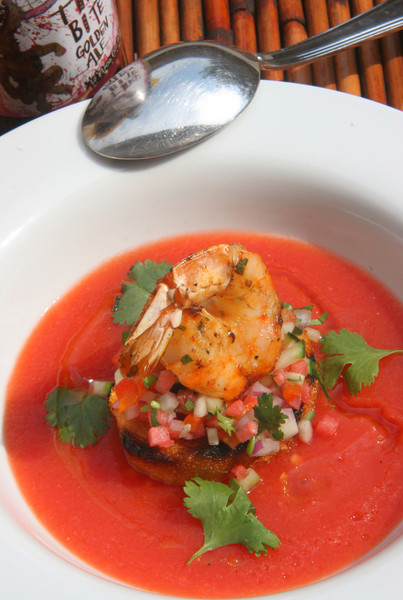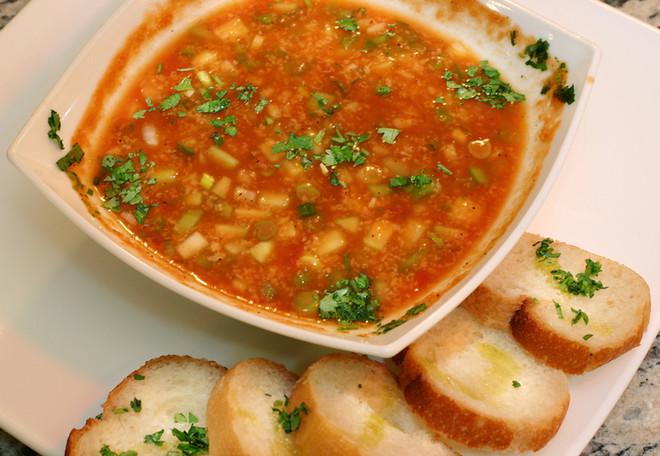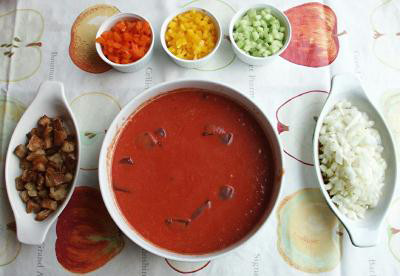 How to cook gazpacho
How to cook gazpacho Today, many chefs use the word "gazpacho"not only the traditional Spanish tomato soup (we will mention the traditional nature of gazpacho later), but also any other cold soup made from raw or uncooked ingredients. In fact, the original gazpacho has very little to do with all the modern variations under the gazpacho brand. And tomatoes appeared on Spanish soil only after Columbus discovered America. Gazpacho appeared much earlier and consisted of a mixture of stale bread, garlic, olive oil, salt and . The combination of salt, garlic and vinegar prevented the body from quickly wasting its water supply, while bread and olive oil saturated it with calories. One of the varieties of gazpacho is ajoblanco, or "white gazpacho". By the way, it was also invented in Andalusia. Ground almonds diluted with water were added to the main ingredients. In the modern version of ajoblanco, you can often find grapes, cucumbers, apple pieces and even fried anchovies. Before the Spanish became acquainted with tomatoes, along with the white version, there was also a green version of gazpacho. Green gazpacho, as you might guess, consisted of herbs that could only be found and eaten. It is believed that the inhabitants of Huelva and Sierra Morena were the first to think of this option. Modern green gazpacho can consist of anything that is green, and not just herbs. With the discovery of tomatoes, the Spanish national dish began a new life. The Spaniards learned through experience that the tomato is an excellent vegetable for making cold soups. It gives a large amount of liquid, has a pleasant sweet and sour taste and an incomparable aroma. A real Spaniard, preparing classic gazpacho, will never put tomato paste in it, as the same Americans can sin with. Only fresh ripe red tomatoes! In addition, the Spanish do not welcome any peppers in such gazpacho. All that is allowed in a real gazpacho, except for tomatoes, is olive oil, preferably produced in Spain itself, wine vinegar of the best quality (preferably sherry), garlic, sea salt and possibly ground cumin (it is added in some regions of Spain). And that's it! As you can see, nothing is said even about ice cubes for greater cooling. In general, the wise Spaniards believe (and they are absolutely right) that a cool liquid is much more refreshing than a very cold one.
Today, many chefs use the word "gazpacho"not only the traditional Spanish tomato soup (we will mention the traditional nature of gazpacho later), but also any other cold soup made from raw or uncooked ingredients. In fact, the original gazpacho has very little to do with all the modern variations under the gazpacho brand. And tomatoes appeared on Spanish soil only after Columbus discovered America. Gazpacho appeared much earlier and consisted of a mixture of stale bread, garlic, olive oil, salt and . The combination of salt, garlic and vinegar prevented the body from quickly wasting its water supply, while bread and olive oil saturated it with calories. One of the varieties of gazpacho is ajoblanco, or "white gazpacho". By the way, it was also invented in Andalusia. Ground almonds diluted with water were added to the main ingredients. In the modern version of ajoblanco, you can often find grapes, cucumbers, apple pieces and even fried anchovies. Before the Spanish became acquainted with tomatoes, along with the white version, there was also a green version of gazpacho. Green gazpacho, as you might guess, consisted of herbs that could only be found and eaten. It is believed that the inhabitants of Huelva and Sierra Morena were the first to think of this option. Modern green gazpacho can consist of anything that is green, and not just herbs. With the discovery of tomatoes, the Spanish national dish began a new life. The Spaniards learned through experience that the tomato is an excellent vegetable for making cold soups. It gives a large amount of liquid, has a pleasant sweet and sour taste and an incomparable aroma. A real Spaniard, preparing classic gazpacho, will never put tomato paste in it, as the same Americans can sin with. Only fresh ripe red tomatoes! In addition, the Spanish do not welcome any peppers in such gazpacho. All that is allowed in a real gazpacho, except for tomatoes, is olive oil, preferably produced in Spain itself, wine vinegar of the best quality (preferably sherry), garlic, sea salt and possibly ground cumin (it is added in some regions of Spain). And that's it! As you can see, nothing is said even about ice cubes for greater cooling. In general, the wise Spaniards believe (and they are absolutely right) that a cool liquid is much more refreshing than a very cold one.

 Another reason to think before you put it ingazpacho ice, - the very structure of the soup, which is achieved not by simply mechanically mixing the ingredients, but by painstakingly combining oil with liquids. It is not for nothing that all recipes repeat: "slowly stream" or "drop by drop" "pour in while stirring constantly" ... All this is done in order to get a pleasant, homogeneous, almost satin structure of the soup! .. And melting ice is not able to add anything to gazpacho except puddles of water, unappetizingly spilled on the surface. However, if you really want to add ice or the same pepper or something else to gazpacho, no Spaniard, of course, will catch you red-handed. Moreover, they themselves are not averse to trying new flavors in an old dish from time to time. However, these are not all the types of gazpacho that Andalusians enjoy. There is another soup that is very similar to tomato gazpacho, but nevertheless, it is significantly different. It is salmorejo, or, as it is also called in Andalusia, ardoria. It owes its origin to Cordoba, a province of Andalusia, and its base is tomatoes, bread, olive oil, garlic and vinegar. A familiar combination of ingredients, isn't it? For salmorejo, tomatoes are peeled and pureed with all of the listed ingredients, and at the end of cooking, chopped ham (Spanish jamon Serrano, of course!) and pieces of hard-boiled eggs are added to the soup. Salmorejo is thicker in structure than tomato gazpacho, this is due to the large amount of bread it contains. Seville-style salmorejoIngredients: 450 g ripe tomatoes, 1 clove of garlic, 50 g stale white bread, 1-2 tbsp. balsamic vinegar, olive oil, sea salt, ground black pepperFor garnish: slices of ham, hard-boiled eggsPreparation: Peel the tomatoes, cut the pulp into pieces, puree in a blender with garlic, add vinegar, salt and pepper. Then add half the amount of bread to the mixture, mix until smooth. Continue adding the remaining bread in small portions along with olive oil, without stopping the mixing process. When the soup acquires a smooth creamy texture, put it in the refrigerator for a while. Before serving, add pieces of ham and chopped eggs to the soup. Serve fresh white bread with the soup. Gazpacho will probably never stop its evolutionary path. Today, we owe the huge number of variations of this dish, including to the chefs of elite restaurants, who, for the sake of Michelin stars, go for such unexpected experiments, as a result of which watermelon, cherry, mango and other gazpachos are born.
Another reason to think before you put it ingazpacho ice, - the very structure of the soup, which is achieved not by simply mechanically mixing the ingredients, but by painstakingly combining oil with liquids. It is not for nothing that all recipes repeat: "slowly stream" or "drop by drop" "pour in while stirring constantly" ... All this is done in order to get a pleasant, homogeneous, almost satin structure of the soup! .. And melting ice is not able to add anything to gazpacho except puddles of water, unappetizingly spilled on the surface. However, if you really want to add ice or the same pepper or something else to gazpacho, no Spaniard, of course, will catch you red-handed. Moreover, they themselves are not averse to trying new flavors in an old dish from time to time. However, these are not all the types of gazpacho that Andalusians enjoy. There is another soup that is very similar to tomato gazpacho, but nevertheless, it is significantly different. It is salmorejo, or, as it is also called in Andalusia, ardoria. It owes its origin to Cordoba, a province of Andalusia, and its base is tomatoes, bread, olive oil, garlic and vinegar. A familiar combination of ingredients, isn't it? For salmorejo, tomatoes are peeled and pureed with all of the listed ingredients, and at the end of cooking, chopped ham (Spanish jamon Serrano, of course!) and pieces of hard-boiled eggs are added to the soup. Salmorejo is thicker in structure than tomato gazpacho, this is due to the large amount of bread it contains. Seville-style salmorejoIngredients: 450 g ripe tomatoes, 1 clove of garlic, 50 g stale white bread, 1-2 tbsp. balsamic vinegar, olive oil, sea salt, ground black pepperFor garnish: slices of ham, hard-boiled eggsPreparation: Peel the tomatoes, cut the pulp into pieces, puree in a blender with garlic, add vinegar, salt and pepper. Then add half the amount of bread to the mixture, mix until smooth. Continue adding the remaining bread in small portions along with olive oil, without stopping the mixing process. When the soup acquires a smooth creamy texture, put it in the refrigerator for a while. Before serving, add pieces of ham and chopped eggs to the soup. Serve fresh white bread with the soup. Gazpacho will probably never stop its evolutionary path. Today, we owe the huge number of variations of this dish, including to the chefs of elite restaurants, who, for the sake of Michelin stars, go for such unexpected experiments, as a result of which watermelon, cherry, mango and other gazpachos are born.

Making Money with Desserts: Success Stories
Evgeniya Polischuk (Fedutinova) instagram:@evgeniyafedutinovavk.com/janeshomebaking– It all started with baking for family and friends. Gradually, I started posting photos of my baked goods on Instagram – and orders started coming in. I made my first custom-made cake on October 13, 2014, and a little earlier I started making macaroons and cupcakes. You could say that the business “found me”, I am very […]

Soups are cold recipes with photos
Cold cucumber soup with yogurt and lemonsorbet from the chef of the restaurant La Taverna Alexander Zhurkin Photo: Getty Images Ingredients: Plain yoghurt – 125 g Cucumber – 150 g Lemon/lime sorbet – 50 g Cocktail shrimp – 24 g Fresh ginger juice – 1 g Lime juice – 5 g Fresh orange juice – 5 g Parsley – 1 g Pink pepper – 1 g Watercress – […]

barbeque kebab
Pork tenderloin in glaze Photo:Dmitry Bayrak/dbstudioPreparation time: 20 minutes + marinating time.Calories: 454 kcal per serving.For 4 servings: 4 pork tenderloins (approximately 300 g each), 1 onion, 2 cloves of garlic, 1 tsp. lemon zest, 1 tsp. lemon juice, a pinch of ground cumin, coriander and turmeric, 1 tbsp. vegetable […]

Pierre Duacan: dietary recipes: Ducane diet
Beetroot soup Photo:Season’S, Luxury Hotels RepresentationYou will need:· Boiled beetroot – 60 g· Fresh cucumbers – 20 g· Red radish – 20 g· Green onions – 10 g· Egg – 1 pc.· Drinking mineral water – 200 g· Salt – 1 gPreparation:· Boil the egg and beetroot.· Grate the cucumbers, radish and part of the beetroot. Put everything […]





